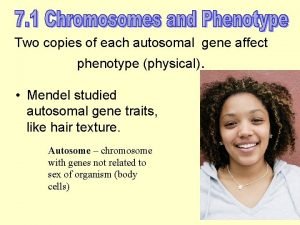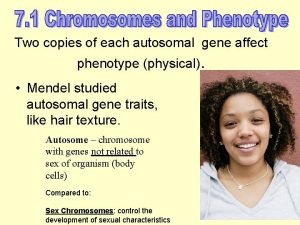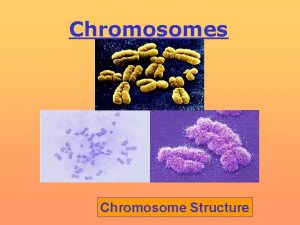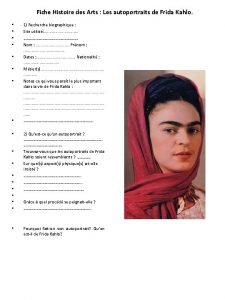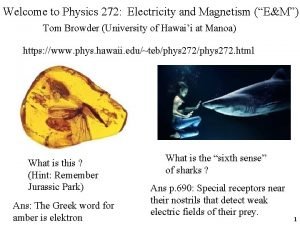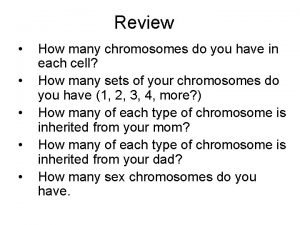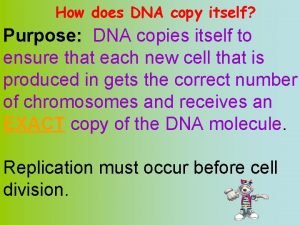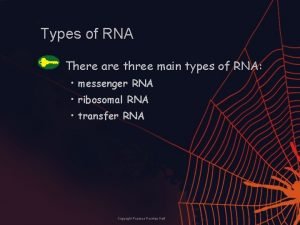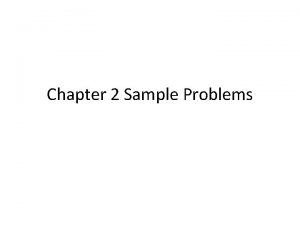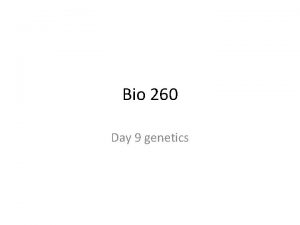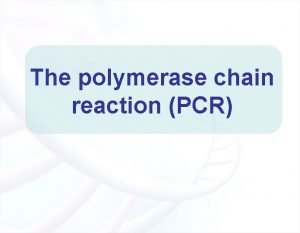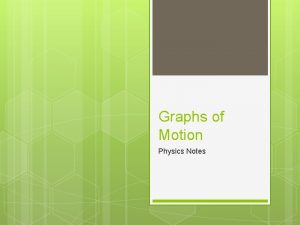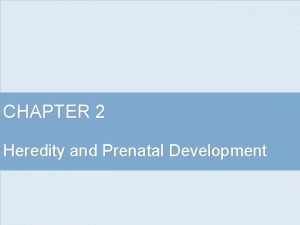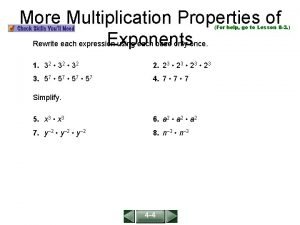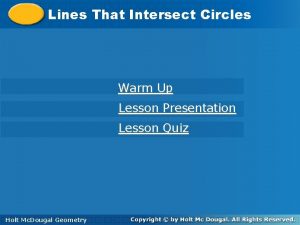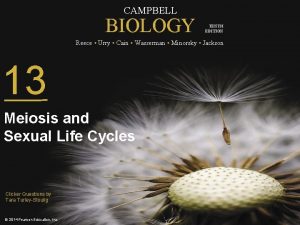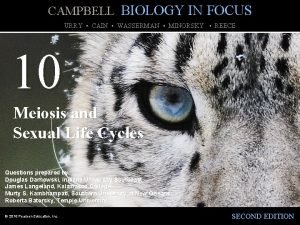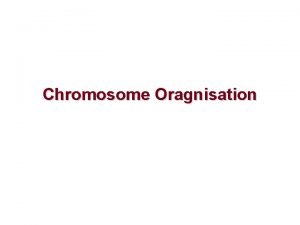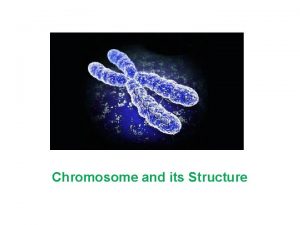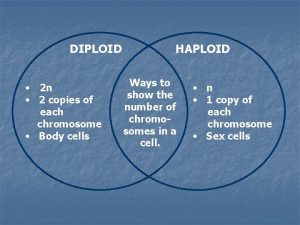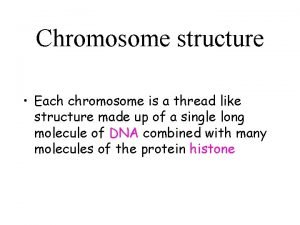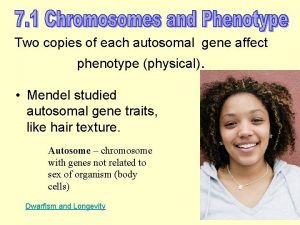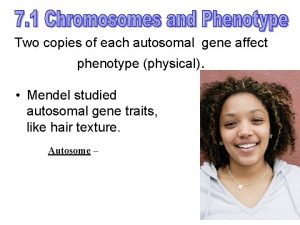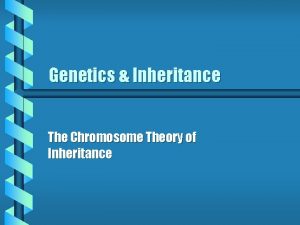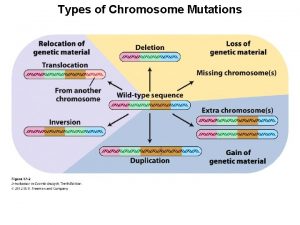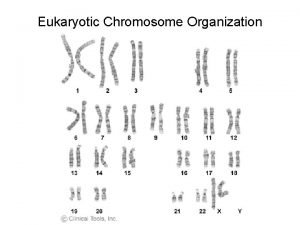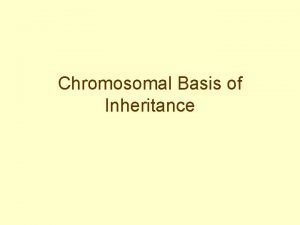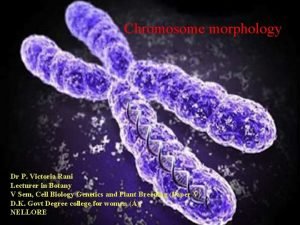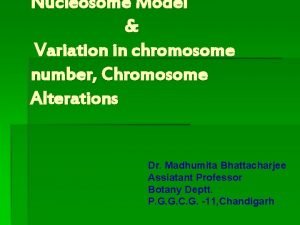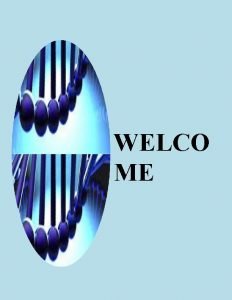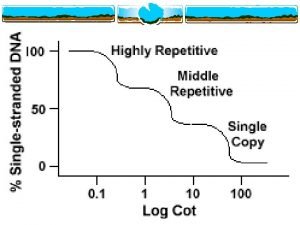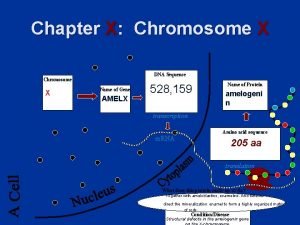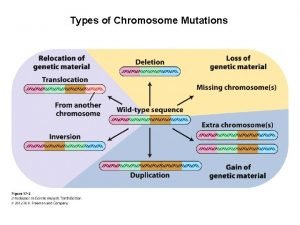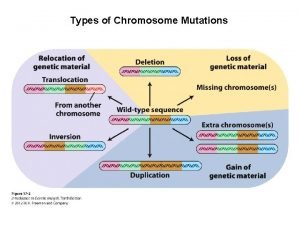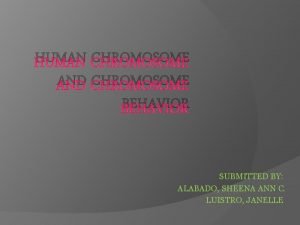If parents have two copies of each chromosome

























- Slides: 25

If parents have two copies of each chromosome, how do they pass on only one to their offspring? • MEIOSIS is the process of cell division that decreases the number of chromosomes to make sperm or egg cells Sperm or egg cells Original cell

The purposes of Meiosis: 1. Split the total number of chromosomes in half so that only ONE chromosome from each pair is inherited from each parent. 2. Produce variation in offspring by randomly sorting the chromosomes.

Meiosis Original cell • Diploid (2 n) (n = # of pairs of chromosomes) Sperm or egg cells (GAMETES) • Haploid (n) (single chromosomes)

Fertilization Sperm Egg Gametes: (haploid sex cells) Zygote: (diploid embryo) Fertilized egg

The Cell Cycle – “life” of the cell 4 stages in cell life: G 1 – Growth, making proteins, doing work S – Synthesis – making a copy of DNA G 2 – Growth (more) getting ready for cell division M – Mitosis or Meiosis – cell division

Mitosis • Produces two identical daughter cells • Each daughter cell has the same kind and number of chromosomes as the original parent cell • Mitosis takes place AFTER DNA replication

Interphase (Resting stage) • Chromosomes cannot be seen • Chromosomes duplicate and double in number • How do the chromosomes duplicate?

Prophase nuclear membrane chromatids centromere disappearing • Chromosomes become visible • Each chromosome consists of two identical chromatids homologous chromosomes

Metaphase Centrosome • Chromosomes line up at the equator (centre of the cell) • Spindles are formed to attach to the centromere of each chromosome (made of 2 centrioles)

Anaphase • Sister chromatids separate as individual chromosomes • They move apart towards the opposite poles chromosomes

Telophase • Chromosomes gradually disappear • Nuclear membrane is formed around each set of chromosomes nuclear membrane forming

Can you identify the different stages of mitosis from the diagram below? anaphase interphase telophase metaphase prophase

Meiosis • Same steps as Mitosis: Prophase, Metaphase, Anaphase, Telophase • Meiosis happens TWICE!!! • Metaphase I, Anaphase II, etc. http: //highered. mcgrawhill. com/sites/0072495855/student_view 0/cha pter 28/animation__how_meiosis_works. html

Some Vocab • Homologous Chromosomes: chromosomes that contain the same genes, but may have different alleles (one is from mom, one is from dad) • Sister Chromatids: identical copies of a single chromosome connected by a centromere

Meiosis 1

Close-up of Metaphase I Crossing over: segments of DNA are exchanged between homologous chromosomes

Law of Independent Assortment • It is random where the chromosomes line up! Mom can be either side, Dad either side.

Meiosis II

Close up of Metaphase II

Summary of Meiosis • Segregation of alleles: one chromosome in each of the 4 cells: only one copy of the allele • Creates 4 haploid daughter cells • Meiosis Video

• Comparison of Mitosis and Meiosis

Mitosis vs. Meiosis Mitosis Meiosis Purpose To produce new cells for To produce new 1) growth 2) replacement gametes for sexual of old or damaged cells reproduction Start with 1 Diploid somatic cell 1 Diploid germ cell (i. e. , skin cells, liver cells, muscle cells, lung cells, etc. ) End with 2 identical Diploid somatic cells 4 haploid gametes Number of cell divisions that occur 1 2

• Demonstration of mitosis and meiosis

Mendel’s Laws related to Meiosis • Law of Segregation • Law of Independent Assortment

Pop bead modeling of meiosis • Follow directions from teacher • Use pop beads to model each step in animation with your teacher • Draw each step on your worksheet Meiosis step 1 Meiosis step 2 Meiosis step 3
 Two copies of each autosomal gene affect
Two copies of each autosomal gene affect Two copies of each autosomal gene affect phenotype
Two copies of each autosomal gene affect phenotype Two parents have each built a toy catapult
Two parents have each built a toy catapult How to read chromosome
How to read chromosome Eye color punnett square hazel
Eye color punnett square hazel Frida kahlo mes parents mes grands parents et moi
Frida kahlo mes parents mes grands parents et moi Parents parents
Parents parents Frida kahlo histoire des arts
Frida kahlo histoire des arts What is this
What is this How many chromosome does a sperm cell have
How many chromosome does a sperm cell have Dna copies itself
Dna copies itself Cned fr espace inscrit
Cned fr espace inscrit Three main types of rna
Three main types of rna Annotations sur les copies
Annotations sur les copies Which sequence correctly summarizes the accounting process
Which sequence correctly summarizes the accounting process Copies of dna
Copies of dna Pcr copies
Pcr copies Margo and her parents (visit-visits) each other often
Margo and her parents (visit-visits) each other often Has six faces 8 vertices and 12 edges
Has six faces 8 vertices and 12 edges When two curves coincide the two objects have the same
When two curves coincide the two objects have the same Can 2 blue eyes parents have a brown eyed child
Can 2 blue eyes parents have a brown eyed child Requires two parents
Requires two parents Use the properties of exponents to rewrite each expression
Use the properties of exponents to rewrite each expression Identify each line or segment that intersects each circle
Identify each line or segment that intersects each circle Privet shrubs and humans each have a diploid number of 46
Privet shrubs and humans each have a diploid number of 46 Privet shrubs and humans each have a diploid number of 46
Privet shrubs and humans each have a diploid number of 46
